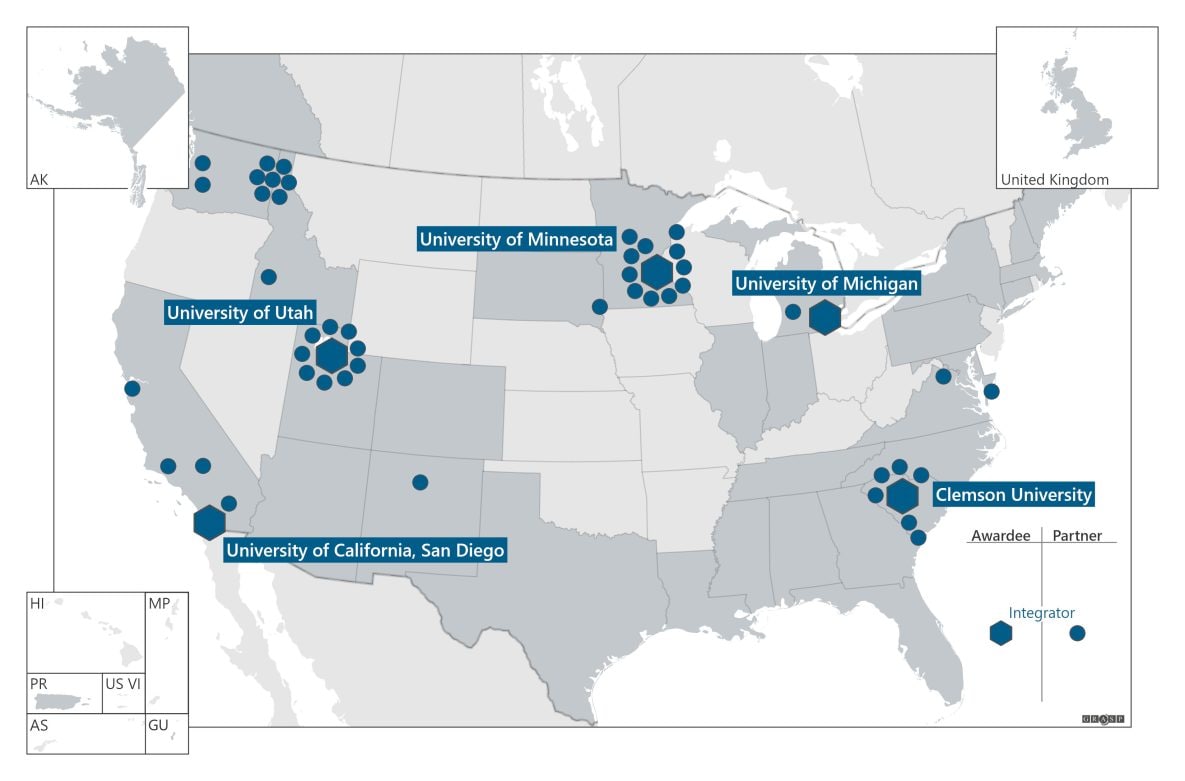Insight Net: Integrators
Can modeling tools enhance decision making in public health?
CDC’s Center for Forecasting and Outbreak Analytics (CFA) established Insight Net to help modernize modeling of infectious disease spread to give public health decision-makers relevant information quickly during outbreaks. Insight Net’s partners called Integrators will test the utility of disease modeling tools in public health and healthcare organizations to see how public health decision-makers benefit from the analyses.
This includes:
- Refining and evaluating analytic approaches created by Innovators and Integrators
- Transitioning outbreak analytic and disease modeling innovations to small-scale operations of the implementing partner
- Establishing mechanisms that support response-ready data collection
- Evaluating and documenting the process and results of the integration effort
CFA funded the following partners to be Integrators:
- University of California – San Diego
- University of Utah
- University of Minnesota
- University of Michigan School of Public Health
- Clemson University

A static image that shows the Insight Net's Integrators.
The University of Utah is developing and implementing tools to improve responses to emerging public health threats across the Mountain West.
1) They formed the Forecasting and Surveillance of Infectious Threats and Epidemics (ForeSITE) center to create tools for local health officials to customize disease responses for their communities. The models also incorporate socioeconomic, race, disability, and other data relevant to health equity, so that local decision-makers can consider equity in their responses and target the most vulnerable populations.
2) During the COVID-19 pandemic, ForeSITE researchers used real-time disease forecasting to advise hospitals on preparing for patient surges, assist health departments in planning vaccine distribution, and make recommendations for the public about using face masks.
3) ForeSITE has partnerships supporting local health departments, hospitals, and Veterans Affairs health systems in Utah, Washington, Idaho, and Montana, working together to coordinate disease outbreak responses more quickly across the Mountain West region.
Who are Insight Net’s Integrators?
Clemson University and its collaborators formed the Disease Modeling and Analytics to inform Outbreak Preparedness, Response, Intervention, Mitigation, and Elimination (DMA-PRIME) center in South Carolina to support readiness and response to infectious disease threats. They will integrate forecasting, outbreak analytics, and decision-support tools that emphasize data visualization and communicate analytic results to public health decision-makers. Their partners include the University of South Carolina, Medical University of South Carolina, Prisma Health, South Carolina Department of Health and Environmental Control, Clemson Rural Health, and South Carolina Center for Rural and Primary Healthcare.
The University of California, San Diego (UCSD), along with its partners, formed the Resilient Shield team, which will systematically connect and test the utility of data from novel surveillance approaches, like wastewater and air surveillance, molecular epidemiology, and smartphone-based exposure notifications to inform model development and predict future disease outbreaks. Their partners include the County of San Diego Department of Health and Human Services; Los Alamos National Laboratory; University of California, San Francisco; University of California, Los Angeles; University of California, Riverside; and University of Washington.
The University of Michigan School of Public Health and its collaborators formed the Michigan Public Health Integrated Center for Outbreak Analytics and Modeling (MICOM). Since 2016, this partnership has been developing modeling tools and data analytic pipelines for use by state public health officials, local government, and the public. The MICOM team is integrating forecasting, transmission modeling, and artificial intelligence methods into Michigan’s public health data visualization and analytic platforms. The team is partnering with the Michigan Department of Health and Human Services.
The University of Minnesota formed the Midwest Analytics and Disease Modeling Center (MADMC) to pilot two approaches to support public health decision-making. Pilot 1: Decision Analytic Infectious Disease Modeling Platform, a mathematical modeling and decision analysis platform; and Pilot 2: Geospatial Health Services Disparity Tool, an electronic health record-enhanced public health response toolkit for geospatial decision-analysis, machine learning, and natural language processing. Their partners include the Minnesota Department of Health, Minnesota Electronic Health Records Consortium, M Health Fairview, Essentia Institute of Rural Health, CentraCare Health Systems, Health Partners, Hennepin Healthcare Research Institute, Mayo Clinic, Allina Health, Children’s Minnesota, Sanford Health, Tribal Health Directors in Minnesota, and the Center for Veteran’s Research & Education of the Minneapolis VA Health Care System.
University of Utah ForeSITE team will implement a library of modeling and analytic approaches to create five toolsets: automated alerting, parameter estimation, scenario planning, forecasting and nowcasting, and economic impact analysis. The ForeSITE team includes the University of Utah, Washington State University, and Utah Department of Health and Human Services, with an extensive network of partners including Washington, Idaho, and Montana state health departments; local health districts in Utah and Washington; University of Utah Health and Intermountain Healthcare regional healthcare organizations; community hospitals in Washington and Idaho; and the federal Veterans Affairs healthcare system.
